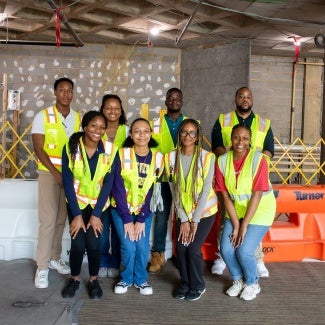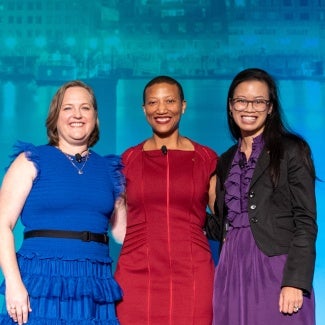50 years of Whitney M. Young Jr.’s historic 1968 AIA speech
Join AIA in commemorating the 50-year anniversary of Whitney Young Jr.’s historic keynote speech at the 1968 AIA National Convention and recognizing the profound legacy of his impact on AIA and architecture.

History & impact of the 1968 speech
Early in 1968, AIA President Robert Durham, FAIA, extended an invitation to the executive director of the National Urban League, Whitney M. Young, Jr., inviting him to deliver a keynote speech at AIA’s National Convention in Portland, Oregon.
President Durham’s invitation came at a time of unprecedented turmoil. In the 1950s and ‘60s, federal money fueled urban renewal projects and the Interstate Highway Program. Intended to improve the conditions of the urban poor, the programs often uprooted entire neighborhoods and had the opposite effect. With a few exceptions, the architectural profession and AIA were silent in the face of the damage being done. Durham sought to change that by inviting Young, saying, “Seldom has there been such a broad public consciousness of the presence of a storm in human affairs.”
In giving the executive director of the National Urban League a keynote spotlight to address some of the most elemental root causes tearing America apart, AIA opened itself to a charismatic speaker whose leadership skills were legendary. Young’s fame as an inspirational and challenging speaker was well known. His moderate approach to matters of socioeconomic disenfranchisement gave him access to corporate leaders and the White House. This brought him to the attention of AIA leadership at a time when the nation’s cities had broken out into violent spasms of armed rebellion over a lack of access to economic opportunity and discriminatory housing practices.
He delivered words that continue to challenge AIA, the profession, and indeed America’s vision of itself as a just society. Young had an important message for a profession he believed had the potential to make a positive difference in the lives of the marginalized and disenfranchised—if its architects chose to do so.
President Durham saw the possibility of a new, hopeful beginning. “It is nevertheless possible to hope that the final judgment of this year will be that it was a beginning of a bright day—a day in which men will have overcome the old dark problems of hate and prejudice, famine and disease, greed and misery.” His appearance in Portland was, to Young, a sign AIA and the profession were seeking a different, more engaged, and constructive path. “By your invitation to me and by your attentiveness to an overly long set of remarks, I am convinced that you are well on your way to becoming as indignant as those who are hurt,” he said.
Young was not the only speaker to challenge the status quo. Lady Bird Johnson urged the profession to become “thoughtful political activists” and work for a “new conservation” concerned with the total human and community environment. A third speaker, economist Barbara Ward, warned of “violence, revolt, and collapse” in the nation’s cities in the face of inaction. But it was Young who had the most profound and lasting impact, warning that the “disinherited, disenfranchised, the poor, and the Black are saying in no unmistakable terms that they intend to be in or nobody will be comfortably in.”
AIA’s response to Young’s message was immediate. At the convention’s business session, two newly drafted resolutions were passed by the delegates. Resolution 10 set in motion the creation of a national scholarship program for members of “disadvantaged minority groups for the purpose of the study of architecture.” Since that time, over two thousand scholarships have been awarded to diverse young people seeking a career in architecture. Resolution 13 specifically referred to Young’s speech and called on architects to “take a positive stand and become personally involved in the issues of our day.”
Young would likely acknowledge positive change within the country and the architectural profession since his 1968 speech. But he would no doubt call to account both the country and the profession for not having yet achieved a truly inclusive and equitable society.—Ray Rhinehart, Hon. AIA
“I would like very much to speak to you as citizens and as a professional group, and simply as men and women.”
The legacy of Whitney M. Young Jr.
In the years that followed Young’s historic speech, AIA passed resolutions, expanded the Code of Ethics, held meetings, and inaugurated programs intended to foster a more inclusive, diverse, and equitable profession. Essays exploring Young’s message and AIA’s progress can be found below.
Discussions of Whitney Young, Jr.’s 1968 remarks to AIA members typically focus on two issues: the absence of Black architects in the profession and what Young described as the profession’s profound “irrelevance” in speaking out on the issues of the day.
Decrying the lack of architects of color as he gazed out at his audience, Young saw their absence as a symbol of larger issues that had an impact on all Americans, specifically equity and disenfranchisement. If the urban poor, largely Black, were denied a voice in shaping their own destiny, so were “poor Appalachian Whites, Mexican-Americans, Puerto Ricans, and Indians.” Programs directed to serve the needs of the urban and rural poor were typically top-down initiatives with little or no input from those affected.
Young pointed out that the lack of diversity in the profession could be cut two ways. The profession was denying itself the full range of human creativity, and by the same token entire communities were not given the opportunity to chart their own future because they were dealing with a profession that neither looked like them nor understood their unique needs.
He set in motion within the national AIA and its chapters an evolving understanding of diversity that, as he had intended, went far beyond the plight of the urban poor and race. A truly inclusive society and profession, he had insisted, meant just that—making room for everyone.
AIA and its chapters pushed for change by the rise of committees focused on various minorities in the profession, convention resolutions that have spoken to issues raised by Young, and the hiring of staff specifically tasked to address these issues. One of the outcomes of real consequence has been a series of revisions to AIA’s Code of Ethics and Professional Conduct that over time have banned discrimination based on race, sex, creed, or national origin (1970), the disabled (1977), and members of the LGBT community (1992).
Young also inspired the AIA/Architects Foundation Diversity Advancement Scholarship, established in 1970 as the AIA/AF Minority Disadvantaged Scholarship, and two years later the creation of the Whitney M. Young Jr. Award. Over time, both have been reshaped by an increasingly broad understanding of who the disenfranchised and underserved are, and who embodies Young’s lifelong commitment to equity and justice.
Ray Rhinehart, Hon. AIA | April 16, 2018
When he raised the issue of diversity and inclusion in front of AIA membership, Whitney Young made no reference to those with physical disabilities. But from the perspective of fifty years on, any commitment to inclusiveness demands a far closer look in the mirror than was imagined even by a visionary advocate for inclusion a half century ago.
In 1936, at the age of nine, Robert Lynch contracted polio. He would never recover the use of his legs. In his senior year, Lynch decided to pursue a career in architecture. His school of choice was Notre Dame, since it was in a flat part of the country. Once on campus, however, Lynch discovered the challenge he faced was not geography, but architecture. Many of his classes were on second and third floors. With no legal and design remedies at hand, Lynch learned to bench press 300 pounds, enabling him to hoist his body and his hip-length steel braces up and down stairs.
Although the building industry, code writers, and the owners of historic properties still wrestle with issues of accessibility, Robert Lynch began practice in a world with no curb cuts, ramps, designated handicap parking, and limited access to public transportation.
The journey taken from then to now was not unlike that faced by women, people of color, and members of the LGBTQ community—long, pain-staking, and often frustrating. Marginalized groups learned from one another tactics to drive change. In 1977, for example, the American Coalition of Citizens with Disabilities staged a ten-city sit in.
AIA became involved at the national level through the leadership of AIA President Leon Chatelain, Jr., FAIA, who was also active in the National Society for Crippled Children and Adults, and in 1967 served for two years as its president. In the early ‘70s, AIA members Edward Noakes, Edward Matthei, and Robert Lynch hosted a 60-person conference which resulted in the creation of the National Center for a Barrier-Free Environment. In making the case for legislative redress, AIA argued that barrier-free design was about making buildings usable by all people. In other words, accessibility was not an add on, but an essential element of good design.
In 1974, AIA’s Barrier Free Task Force, chaired by Noakes, proposed AIA add to its Code of Ethics an “inherent right” clause that made barrier-free a civil rights issue. In 1986, the National Council on Disability drafted the first version of the Americans with Disabilities Act (ADA). President George H.W. Bush signed the ADA into law in the summer of 1990.
There are no statistics that measure the distance between Robert Lynch’s first years of practice and where we are now when it comes to the number of women and men with disabilities pursuing successful careers in architecture. But there is no doubt their inclusion in the profession has brought with it unique perspectives that have not only enriched the practice of architecture and communities everywhere, but also architecture. Design is not the whole answer, but as the long and ultimately successful campaign to foster barrier-free design shows, it is essential to shaping a truly diverse, inclusive, and equitable world.
Ray Rhinehart, Hon. AIA | April 16, 2018
For AIA and the profession, one of the most far-reaching outcomes of the civil rights movement was the rise of participatory design. The civil unrest of the ‘60s injected a new and urgent vitality into local democracy. Citizens demanded a role in the shaping of their communities.
As the executive director of the National Urban League, Whitney Young was keenly aware of the marginalized, especially the urban poor. Having laid bare the profession’s glaring lack of diversity, Young turned to the role of architects in the “renewal” projects that were tearing apart America’s cities.
In the panel discussion that followed his presentation at the 1968 Convention, Young got to the heart of why even the best intended urban renewal schemes were doomed to fail. There were architects who felt the same sense of urgency. Pioneering professionals such as Jules Gregory and Max Bond challenged the profession to ask those who lived in inner cities what their perceptions and goals were. Positive change, they believed, could not be imposed from above. It had to be inclusive. It had to be generated from within the community.
Understandably, Young was not fully aware of the countercurrent running against the prevailing top-down urban planning strategies, because these architects were working in isolation. This was beginning to change in the ‘60s with the rise nationally of the community design center movement, and within AIA through a new idea that came from an unexpected quarter.
In early 1967, James Bell, president of the Rapid City, South Dakota, Chamber of Commerce, was in Washington. Having some time on his hands, he dropped by AIA to visit with Andy Euston, then AIA’s Director of Urban Programs. Was there something, Bell asked, architects could do to help Rapid City with some serious problems?
Out of that conversation, Jules Gregory, FAIA, suggested that a small group of experienced professionals go to Rapid City as volunteers and confer with local government officials and citizens on site. That was the beginning of AIA’s Regional/Urban Design Assistance Team program (R/UDAT). Since the formation of that first team, AIA’s Centers for Communities by Design has provided over 200 localities with pro bono design assistance and community-driven planning processes. Paired with the programs of chapters, cities, universities, and other organizations that have replicated similar models, the number of communities improved climbs to over 1000. What they share in common is an inclusionary approach to building community by design.
The civil rights movement gave impetus to an inclusive approach that continues to enrich communities large and small. Whitney Young’s call for the architectural profession to give marginalized citizens a voice in shaping their own destinies came at a uniquely auspicious time when there was a small group of architects prepared to respond to his challenge. Together, they transformed the future of architecture and urban design.
Ray Rhinehart, Hon. AIA | April 16, 2018
Tribute to Whitney Young
About Whitney M. Young Jr.
The short life & long impact of Whitney M. Young Jr.
Whitney Moore Young Jr. was born in 1921 just west of Louisville, Kentucky on the campus of Lincoln Institute—an African American high school where his father was head principal and president. Young graduated from the school as class valedictorian, before earning an undergraduate degree in social work from Kentucky State University in 1941.
During World War II, he was trained as an electrical engineer at the Massachusetts Institute of Technology and later assigned to a road construction crew of African American soldiers supervised by Southern white officers. Promoted from private to first sergeant in just three weeks, Young faced hostility from both groups. Despite the tension, he would serve as a bridge between the white supervisors and black soldiers angry at their poor treatment. Young credited the situation as sparking his lifelong interest fighting for civil rights.
After the war, Young earned a graduate degree in social work at University of Minnesota in 1947 and worked with the St. Paul branch of the National Urban League. After a directorship with the Urban League’s branch in Omaha, Nebraska, he served as dean of Clark Atlanta University’s social work program and became active in the Atlanta National Association for the Advancement of Colored People (NAACP). In 1960, he was elected president of Georgia NAACP and studied at Harvard University under a Rockefeller Foundation grant.
In 1961, the 40-year-old Young was selected as executive director of the National Urban League, taking charge of the organization as civil rights protests began to sweep across the United States. While the Urban League still maintained its founding mission—supporting the African American workforce—Young would transform the organization into a major civil rights group. Young used his position with the League to pressure major corporations to hire more African Americans.
A close ally of Martin Luther King Jr., Young helped organize the March on Washington and fostered closer relations within the federal government. Uninterested in entering politics himself, Young advised Presidents Kennedy and Johnson, and turned down a potential cabinet post offered by President-elect Richard Nixon. Young led the Urban League until his death at 49 during a 1971 swimming accident in Lagos, Nigeria.
AIA’s commitment to diversity
AIA is dedicated to bringing architects and communities together. We are committed to broadening equity, diversity, and inclusion to create a stronger profession and promote Equity in Architecture. AIA seeks to examine and support a diverse workforce through initiatives such as the Diversity Recognition Program and the Diversity in the Profession of Architecture Survey and build a stronger pipeline through K-12, Higher Education, and Emerging Professionals programs.









